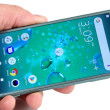Review: Honor 7X
Dec 22, 2017, 2:15 PM by Eric M. Zeman


The Honor 7X is an affordable handset from Huawei that offers modern features in an attractive piece of hardware. This Android smartphone includes a metal-and-glass design, dual cameras with portrait mode, and a large 2:1 display. For those who prefer unlocked smartphones, the Honor 7X is a contender with considering. Here is Phone Scoop's in-depth review.
Hardware
Is It Your Type?
The Honor 7X, made by Huawei, is an affordable, unlocked Android handset that serves as an alternative to carrier-branded devices. It adopts many modern must-haves, including a metal chassis, 2:1 display, and dual camera array. It's one of the first to deliver all of these things at this low of a price. Does Huawei's budget brand deliver the goods? We have the answer.
Body
The Honor 7X is an update to last year's Honor 6X. It makes measurable strides in design, materials, and performance.
The 7X is formed by a unibody aluminum chassis that serves as the entire rear panel of the phone and side edges. A curved, 2.5D glass panel sits within the chassis. The 7X has rounded corners and edges that bend pleasingly around the side of the phone. One might call the shape similar to that of the iPhone 7/8. The aluminum chassis is strong and sturdy, while the glass is polished and smooth. The different paint options (blue, gold, black) have a pleasant matte finish to them.
It's not a unique handset by any stretch of the imagination, but it's a huge improvement over the uneven look of the 6X. More importantly, the design goes toe-to-toe with the options on carrier shelves — and sometimes kicks them in the shins.
The 7X may be slim, but it isn't compact. The large 2:1 screen means the phone stands pretty tall at 6.15 inches. Thankfully it measures under 3 inches wide, which helps keep hand fit somewhat in check. I think some people will consider the phone too big, but I like the size. Huawei did well to keep the thickness to 7.6mm. Due to the smooth shape and narrow profile, the phone slips into most pockets without trouble.
The metal chassis and glass panel are well-made and put together tightly. You can't ask for a nicer blend of materials and construction. It puts similarly priced plastic handsets to shame. The weight is fine and gives me confidence in the phone's quality.
Hand Fit

The phone's face is similar to others that rely on the 2:1 aspect ratio display. There are practically no bezels along the side edges, and Honor kept the top and bottom bezels in check. The speaker grille and user-facing camera are barely visible above the screen, while the Honor logo is plainly visible below thanks to reflective chrome paint. There are no physical buttons on the front, as the 7X makes use of on-screen controls.
You'll find the volume toggle and screen lock button on the phone's right edge. They don't quite stick out enough. The volume toggle is closer to the top. It's flat and smooth. Travel and feedback is just okay. The screen lock button is a bit closer to the 7X's waist. I didn't have any trouble finding it, though it feels slightly mushy when pressed.
Honor tucked the SIM card tray in the left edge of the phone, close to the top. It also supports memory cards, or a second SIM card if you wish.
The 7X includes a 3.5mm headphone jack on the bottom, but perplexingly relies on microUSB rather than USB-C for charging. This is a major misstep these days, even for a budget phone.
MicroUSB
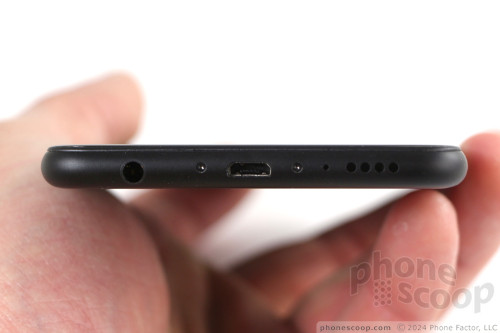
I really like the smooth, flat look of the rear panel. You'll see some antenna lines crossing the back near the top and bottom edges. A fingerprint sensor is positioned perfectly on the back. It's indented a bit, making it easy to find and use. The 7X includes two rear cameras, which are perched close to the top of the phone. Each of the circular lenses protrudes just a little bit. They sort of look like frog eyes.
Cameras

The unibody construction means the battery is inaccessible. The phone is not designed to be "rugged", nor is it water-resistant.
In sum, Honor has crafted a fine piece of hardware for the money.
Profile
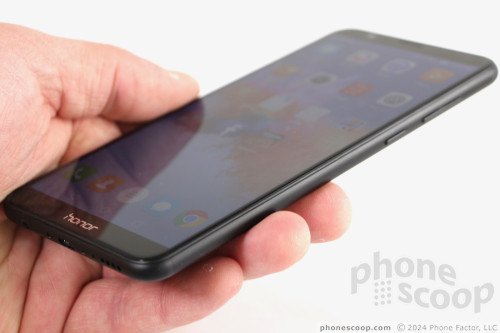
Screen
The 5.93-inch display adopts the 2:1 aspect ratio with HD+ resolution (2,160 by 1,080 pixels). This is almost identical to the size/resolution of Huawei's Mate 10 Pro flagship device, though the Honor 7X uses LCD technology.
The screen is sharp and bright. The screen offers solid pixel density (401ppi) for clean icons, text, and graphics. The LCD panel puts out plenty of light for use indoors; I thought it worked well outdoors, too. Colors are accurate. I noticed significant brightness drop when the screen is viewed at an angle, but there's no color change.
You really can't ask for a better screen at this price point.
The phone includes several software tools for tweaking color saturation, brightness, eye fatigue, and such.
Signal
Huawei sells the Honor 7X unlocked. It supports LTE Bands 2 / 4 / 5 / 7 / 12 / 17, which gives it basic support for AT&T/Cricket and T-Mobile/MetroPCS. It lacks support for either carrier's newer LTE bands, such as AT&T's 29/30 or T-Mobile's band 66. I tested the phone on T-Mobile's network in and around NYC and was pleased overall.
The phone latched onto T-Mobile's network and offered 4G service nearly everywhere I took it. Data speeds were on par with similar-class phones. The phone did well when it came to perusing social networks, checking email, and the like. Streaming media was mostly good, though I some some buffering and low-resolution audio/video performance from time to time.
Calls connected consistently on the first dial, but the phone dropped several calls at highway speeds.
Sound
If you ever bother to make calls with the Honor 7X, you'll be happy with the way they sound. I know I was. Voices come through the earpiece with clarity and punch. I did have to keep the volume set all the way up most of the time, but when I did, I was able to hold conversations in most places I took the phone. Whether I was in a coffee shop, busy mall, or windy alleyway, the 7X gave me the earpiece power I needed to talk to people. Those I spoke to through the 7X said I sounded "pretty good."
The speakerphone delivers solid performance. It can produce enough volume for use at home, in the office, and even a moving car. You will need to turn it up all the way in the car, and doing so introduces quite a bit of scratchy distortion.
Ringers and alerts did their job, and the vibrate alert managed to get my attention when needed.
Battery
Huawei selected a good-sized 3,340mAh battery for the Honor 7X and it does a fine job. The 7X pushes from breakfast to bedtime without breaking into an electronic sweat. On most days I tested the handset it was still holding onto about 30% battery capacity by the time I was ready to call it a day, even under the most intense use. That bodes well for most people.
Disappointingly, the 7X doesn't support rapid charging, nor wireless charging.
Bluetooth, GPS, NFC, WiFi
I didn't run into any issues using the 7X's bastion of secondary radios. Bluetooth, for example, paired and connected with a variety of devices including phones, PCs, speakers, and headsets. Phone calls sent through my car's hands-free system were above average and calls patched via headphones sounded very good. Music pushed to a pair of Bluetooth headphones wasn't as clear or punchy as I would have liked.
The phone does not include an NFC radio, which is a shame.
As a navigation tool, the 7X performed as well as any other unlocked phone. The GPS radio pinpointed me rapidly and to within about 25 feet most of the time. It coordinated with Google Maps and worked fine when put to use for voice-guided, point-to-point directions.
The 7X's WiFi radio did its job.
For those who still listen to FM radio, you'll be happy to learn that the 7X has you covered. As long as you have some wired headphones handy (a common requirement), you can enjoy your favorite FM stations on the go.
Software
Lock Screen
The 7X's lock screen is fairly typical for an Android handset. The phone doesn't offer anything like an always-on display, but you can choose to have notifications wake the screen. This tool, which is an all-or-nothing affair, wakes the lock screen fully to show incoming notifications. Using it will likely drain your battery.
Lock Screen

You'll find the clock at the bottom of the lock screen — accessible with a quick press to the lock screen button — along with the date and a shortcut to the camera. Notifications populate the middle of the screen in the order they are received. You can dismiss notifications from the lock screen, but not act on or reply to them.
Honor has its own lock screen dock that's somewhat useful. You can access some basic tools (voicemail, calculator, flashlight, and camera) by swiping up from the bottom of the screen in a manner similar to Apple's iOS.
The fingerprint reader is easy to set up and I recorded a couple of fingerprints in no time. The reader recognized my print on the first attempt the majority of the time. I've seen faster, but the 7X's reader is certainly fast enough. You can opt to use the fingerprint sensor for opening the Quick Settings / notification shade by swiping down.
The 7X includes a few gestures, as well, such as flip-to-mute, pick-up to silence ringer, and lift-to-ear to answer incoming calls.
Home Screens
Honor's “Emotion UI” 5.1 is a somewhat heavy skin slathered on top of the Android 7 Nougat operating system.
Home Screen
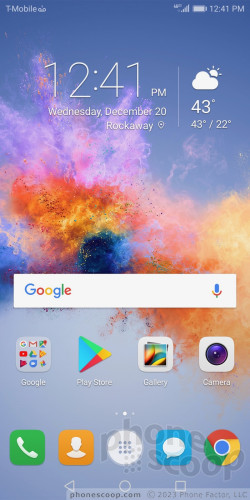
I'm happy to report that Huawei has seen the light and an app drawer is active by default. The settings allow you to turn the app drawer off if you want, which means all the installed apps appear on the home screens.
The Honor 7X supports the typical set of wallpapers, shortcuts, and widgets. I like that Emotion UI includes a handful of screen transitions to choose from, and allows the home screens to loop. You can adjust font and icon sizes, rearrange the navigation keys, take advantage of the floating dock for quick access to certain controls, turn on the one-handed UI (shrinks the screen to one corner), flip to "simple mode" for easy operation, and much more. EMUI 5.1 does offer a lot of control over the experience.
The notification shade / Quick Settings drop-down works as expected. When you swipe down, the shade reveals five toggle controls, a brightness slider, and notifications. Since the phone is running Nougat, you have lots of options when it come to interacting with incoming notifications. The Quick Settings tool provides plenty of room for customization, though it is dressed up with Huawei's colors and fonts.
The full settings menu includes a lot of customization options.
The 7X relies on Huawei's mid-range Kirin 659 processor rather than silicon from Qualcomm. It is clocked at 2.4 GHz and paired with 3 GB of RAM. I didn't run into any performance problems during my time testing the phone. Screen transitions were smooth, apps opened swiftly, and the overall experience was positive.
Camera
The 7X has a good camera app and there are several for options for launching it. A double tap of the lower volume toggle will open the camera, or you can use the lock screen shortcut. It opens swiftly.

The basic layout is typical of most camera apps. Using the controls on the left side of the screen you can jump to the selfie camera, turn on the motion picture mode, portrait mode, aperture mode, or toggle through the flash controls. The shutter controls are all on the right.
Swipe right from the main viewfinder to access the myriad shooting modes and swipe left to access the settings menu. Shooting modes include photo, pro photo, video, pro video, HDR, panorama, light painting, time lapse, slow-motion, filter, effects, watermark, and audio note.
The portrait mode and wide-aperture mode, both accessible from the camera's main viewfinder, are similar in that they put the 7X's two cameras to use in order to create sharp focus around the subject with a blurred backgrounds.
The portrait mode targets people and does... just okay. You'll see some odd outlines around your subject's head with weird in-focus pieces of the background. At least the tool is point-and-shoot simple to use.
The aperture mode is meant to apply the same effect to things more so than people. In order to get this bokeh tool to work, you need to place the subject within about 5 feet of the camera and ensure that there's plenty of distance between the subject and whatever is behind it. It takes practice.
The pro photo and video modes allow you to manually adjust exposure, brightness, white balance, ISO, focus type, and shutter speed. This is great for those who know what they're doing. The sliding tools, all available from the right edge of the viewfinder, make sense and are easy enough to use. The camera maxes out at 8-second exposures.
The watermark tool lets you add a time, date, location, weather stamp to your photo. The light painting mode is for capturing long exposures of headlights/taillights, flashlights, or other light sources. Audio note records several seconds of sound along with a still image. I found them easy to use.
The selfie camera has a significant number of its own shooting modes. The basic selfie cam lets you use the portrait tool, but you can also take selfie panoramas, selfie timelapses, selfie audio notes, and selfie watermarks. The tools may mirror those of the main camera, but stuff like the selfie pano lets you do fun things such as include huge items in the background. Effects are available, too, if you like to put Instagram-style filters on your photos.
I have no complaints about the camera's performance. Truly, it's quick to do everything. The Kirin 659 processor and 3 GB RAM combo do their job well here.
Photos/Video
The main full-color sensor has a resolution of 16 megapixels, while the secondary, monochrome sensor has a resolution of 2 megapixels. It is used mostly to gather contrast and depth-of-field data. I'd rate the 7X as very good for everyday photo needs. The majority of images were sharp, showed acceptable exposure, and maintained proper white balance. This goes for images taken indoors and out. Outdoor shots looked best, of course, but indoor pictures were mostly free of grain and other artifacts common in low-light imagery. The phone did tend to overexpose shots from time to time. The extra shooting modes produce usable results without too steep a learning curve. Bottom line: the Honor 7X does a fine job.
The 8-megapixel selfie camera is about average. Exposure wasn't as consistent, focus was somewhat soft, and the software doesn't quite deliver the best results in the selfie portrait mode. The alternate shooting tools do open the door for creativity, and useful options such as the screen-based flash mean you have a better chance of success.
Whether you're shooting outdoor scenes or up up-close personals, the 7X includes a fine set of cameras.
The 7X records video at a max resolution of full HD (1080p) and the results are good. The video camera includes an object-tracking tool to help keep your subject in focus. Most video looks good, with crisp focus, accurate exposure, and proper white balance.
Wrap-Up
The Honor 7X is an excellent option for people who want something off the beaten track. You won't find it in carrier stores, but this unlocked handset delivers enough performance to put other budget-friendly handsets to shame.
The overall shape may border on boring, but the metal-and-glass construction outguns the plastic alternatives by a significant margin. The screen is very good, voice and data performance is good, and battery life is excellent for this class of handset. You'll find an headset jack and FM radio, though some might be annoyed by the microUSB port.
Huawei's EMUI 5.1 may be a bit heavy-handed, but it does offer a plethora of customization options that let people fully tweak their experience. More to the point, the skin doesn't seem to hinder performance, which was good across the board.
The camera app offers all the features people want in a phone these days and also captures very good photos.
The phone's killer feature is its price tag. At just $199, the Honor 7X is an amazing value. It matches the performance of phones we love, like the Moto X4, at half the cost. As long as you don't mind jumping through some hoops online to find the Honor 7X, it's one of the best $200 phones available.
Profile

Comments
No messages



























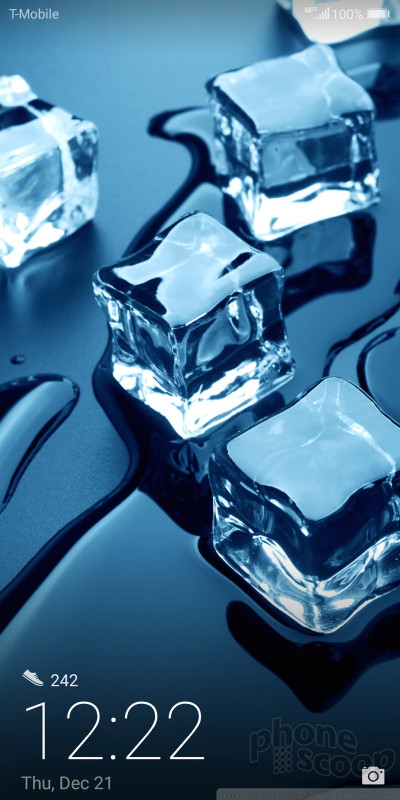





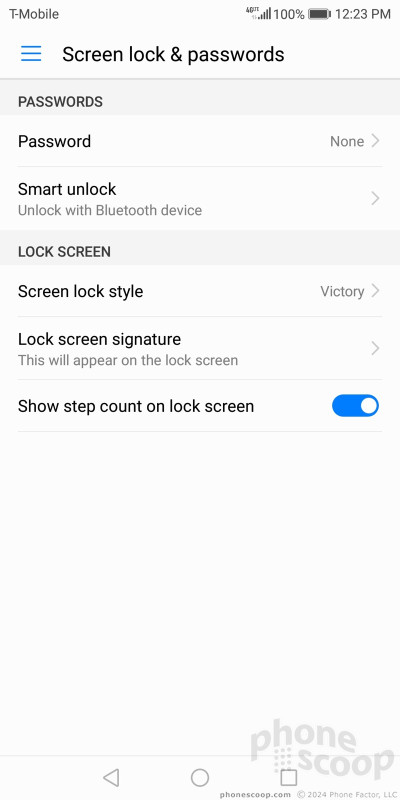







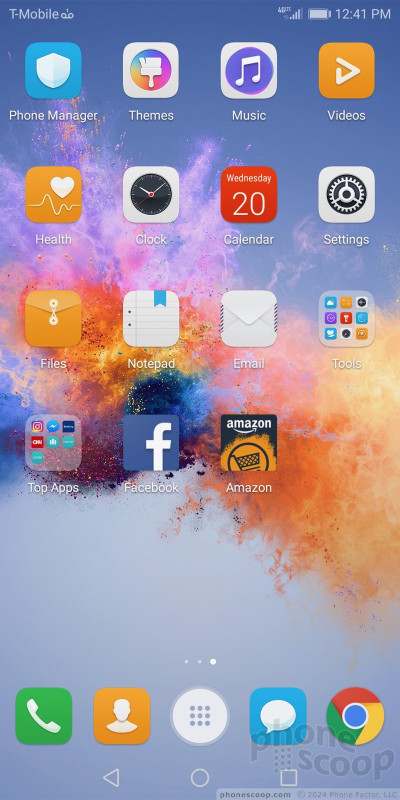








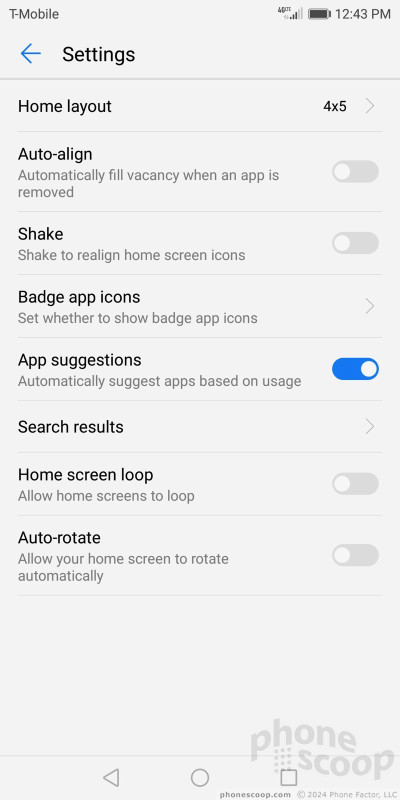













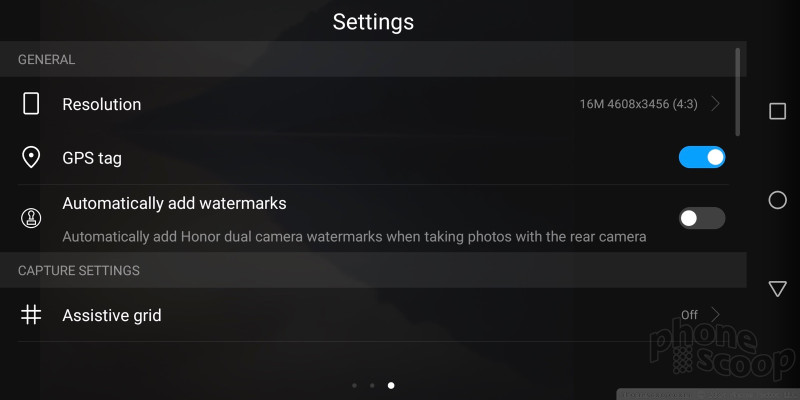

























 Top Five Budget Handsets of 2017
Top Five Budget Handsets of 2017
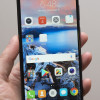 Hands On with the Honor 7X and V10
Hands On with the Honor 7X and V10
 Honor Says Android 8 with EMUI 8 Hitting Honor 7x April 30
Honor Says Android 8 with EMUI 8 Hitting Honor 7x April 30
 Huawei Mate 10 SE Is an Upgraded Honor 7X
Huawei Mate 10 SE Is an Upgraded Honor 7X
 OnePlus 5T and Honor 7X Now Available In Red
OnePlus 5T and Honor 7X Now Available In Red
 Huawei Honor 7X / Mate SE
Huawei Honor 7X / Mate SE


